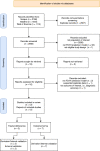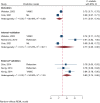Fascial Dehiscence and Incisional Hernia Prediction Models: A Systematic Review and Meta-analysis
- PMID: 36102959
- PMCID: PMC9636101
- DOI: 10.1007/s00268-022-06715-6
Fascial Dehiscence and Incisional Hernia Prediction Models: A Systematic Review and Meta-analysis
Abstract
Background: Fascial dehiscence (FD) and incisional hernia (IH) pose considerable risks to patients who undergo abdominal surgery, and many preventive strategies have been applied to reduce this risk. An accurate predictive model could aid identification of high-risk patients, who could be targeted for particular care. This study aims to systematically review existing FD and IH prediction models.
Methods: Prediction models were identified using pre-specified search terms on SCOPUS, PubMed, and Web of Science. Eligible studies included those conducted in adult patients who underwent any kind of abdominal surgery, and reported model performance. Data from the eligible studies were extracted, and the risk of bias (RoB) was assessed using the PROBAST tool. Pooling of C-statistics was performed using a random-effect meta-analysis. [Registration: PROSPERO (CRD42021282463)].
Results: Twelve studies were eligible for review; five were FD prediction model studies. Most included studies had high RoB, especially in the analysis domain. The C-statistics of the FD and IH prediction models ranged from 0.69 to 0.92, but most have yet to be externally validated. Pooled C-statistics (95% CI) were 0.80 (0.74, 0.86) and 0.81 (0.75, 0.86) for the FD (external-validation) and IH prediction model, respectively. Some predictive factors such as body mass index, smoking, emergency operation, and surgical site infection were associated with FD or IH occurrence and were included in multiple models.
Conclusions: Several models have been developed as an aid for FD and IH prediction, mostly with modest performance and lacking independent validation. New models for specific patient groups may offer clinical utility.
© 2022. The Author(s).
Conflict of interest statement
All authors declare no conflict of interest.
Figures



Similar articles
-
Signs and symptoms to determine if a patient presenting in primary care or hospital outpatient settings has COVID-19.Cochrane Database Syst Rev. 2022 May 20;5(5):CD013665. doi: 10.1002/14651858.CD013665.pub3. Cochrane Database Syst Rev. 2022. PMID: 35593186 Free PMC article.
-
The comparative and added prognostic value of biomarkers to the Revised Cardiac Risk Index for preoperative prediction of major adverse cardiac events and all-cause mortality in patients who undergo noncardiac surgery.Cochrane Database Syst Rev. 2021 Dec 21;12(12):CD013139. doi: 10.1002/14651858.CD013139.pub2. Cochrane Database Syst Rev. 2021. PMID: 34931303 Free PMC article.
-
Cost-effectiveness of using prognostic information to select women with breast cancer for adjuvant systemic therapy.Health Technol Assess. 2006 Sep;10(34):iii-iv, ix-xi, 1-204. doi: 10.3310/hta10340. Health Technol Assess. 2006. PMID: 16959170
-
Magnetic resonance perfusion for differentiating low-grade from high-grade gliomas at first presentation.Cochrane Database Syst Rev. 2018 Jan 22;1(1):CD011551. doi: 10.1002/14651858.CD011551.pub2. Cochrane Database Syst Rev. 2018. PMID: 29357120 Free PMC article.
-
Abdominal wound dehiscence and incisional hernia prevention in midline laparotomy: a systematic review and network meta-analysis.Langenbecks Arch Surg. 2023 Jul 7;408(1):268. doi: 10.1007/s00423-023-02954-w. Langenbecks Arch Surg. 2023. PMID: 37418033
Cited by
-
Occurrence and prevention of incisional hernia following laparoscopic colorectal surgery.World J Gastrointest Surg. 2024 Jul 27;16(7):1973-1980. doi: 10.4240/wjgs.v16.i7.1973. World J Gastrointest Surg. 2024. PMID: 39087097 Free PMC article.
-
A postoperative body weight increase is a novel risk factor for incisional hernia of midline abdominal incision after elective gastroenterological surgery.Langenbecks Arch Surg. 2023 Nov 30;408(1):452. doi: 10.1007/s00423-023-03193-9. Langenbecks Arch Surg. 2023. PMID: 38032404 Clinical Trial.
-
Superiority trial for the development of an ideal method for the closure of midline abdominal wall incisions to reduce the incidence of wound complications after elective gastroenterological surgery: study protocol for a randomized controlled trial.Trials. 2024 May 17;25(1):327. doi: 10.1186/s13063-024-08167-w. Trials. 2024. PMID: 38760769 Free PMC article.
-
The sagitta in 3D reconstruction of linea alba on routine CT scans is predictive of postoperative burst abdomen.Hernia. 2025 Mar 12;29(1):117. doi: 10.1007/s10029-025-03303-0. Hernia. 2025. PMID: 40069372 Free PMC article.
-
Risk factors for incisional hernia after open abdominal aortic aneurysm repair: a systematic review and meta-analysis.Hernia. 2024 Dec;28(6):2137-2144. doi: 10.1007/s10029-024-03182-x. Epub 2024 Sep 26. Hernia. 2024. PMID: 39325326
References
Publication types
MeSH terms
LinkOut - more resources
Full Text Sources

